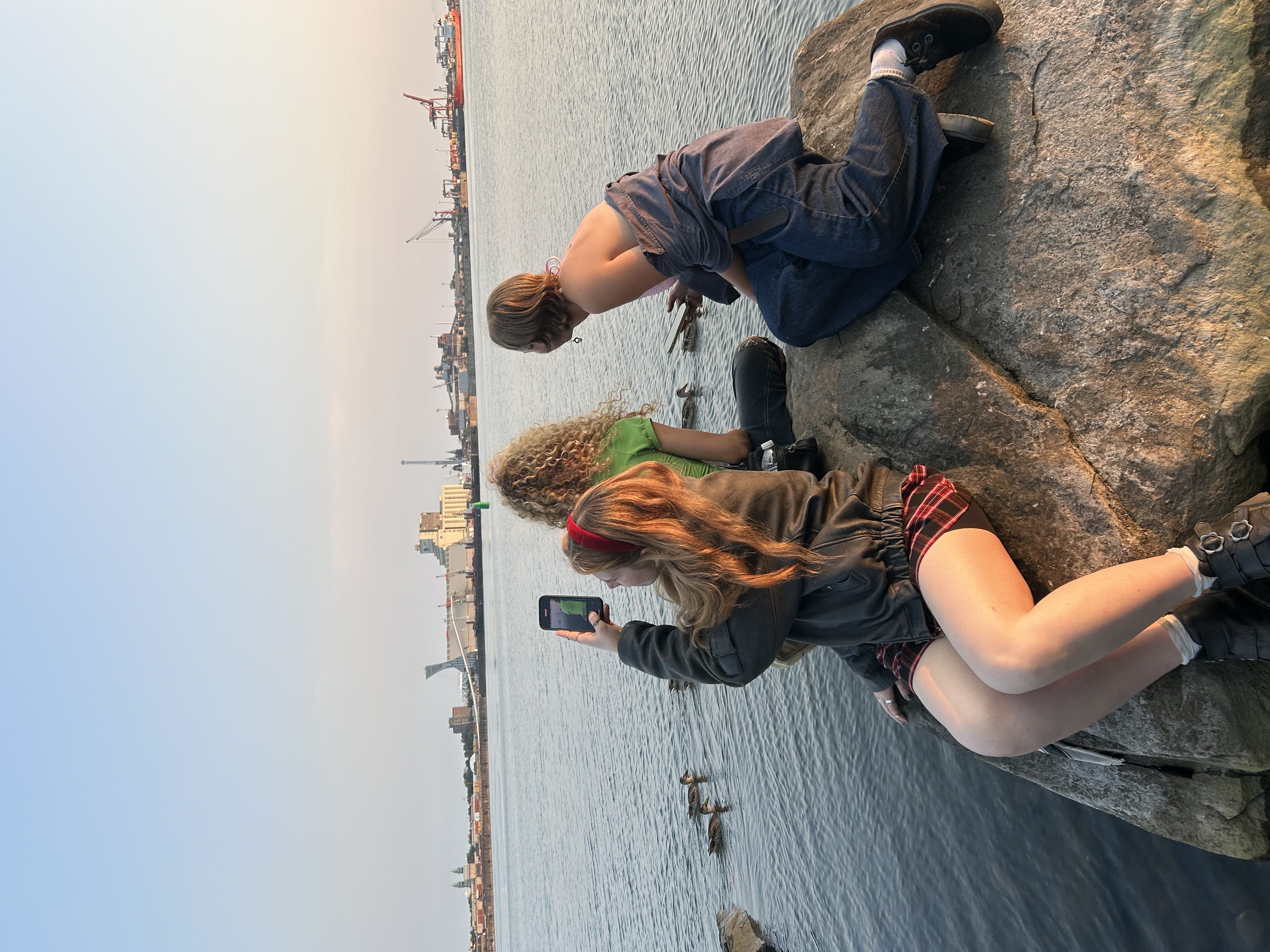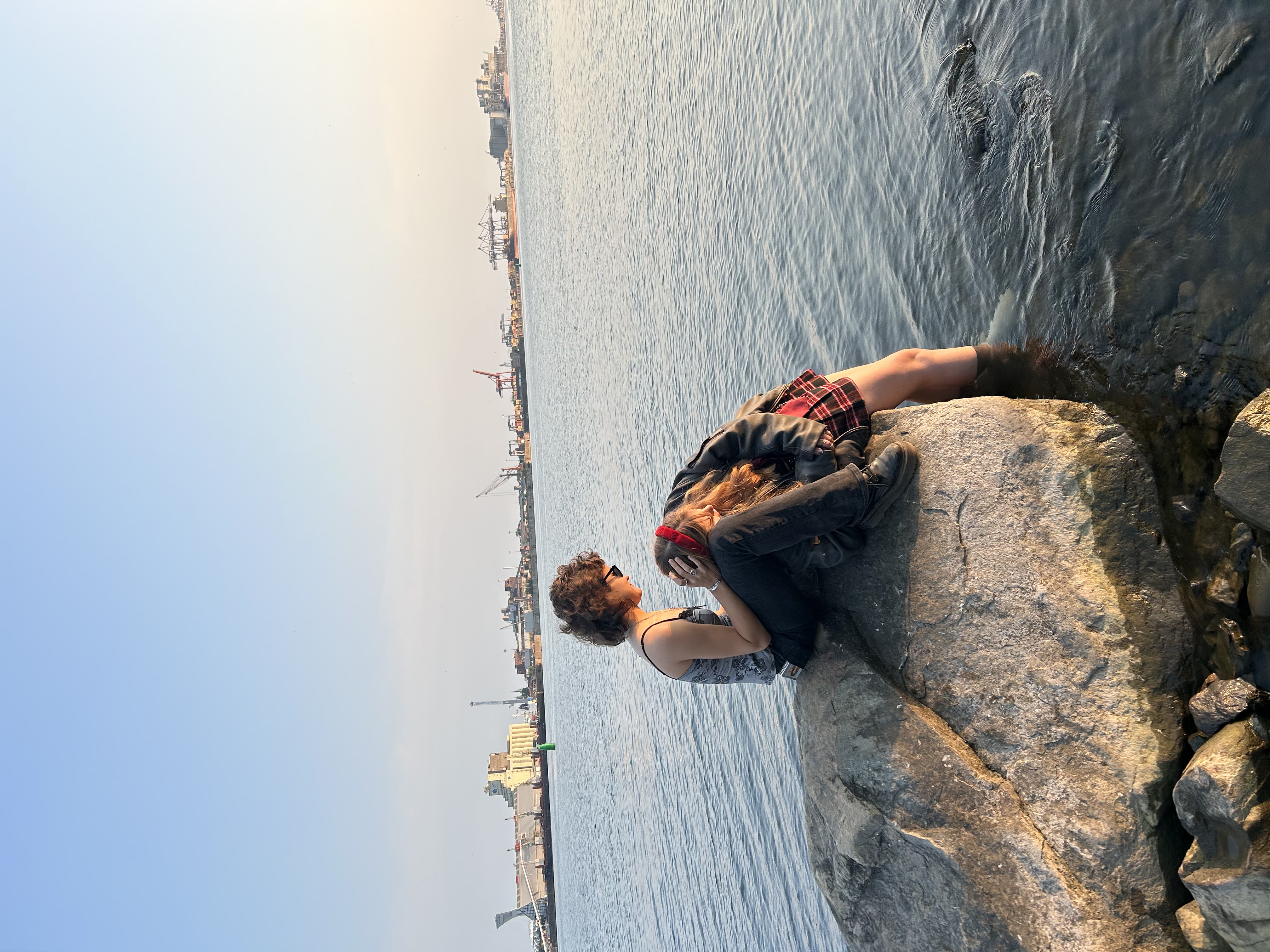NIGHT RAT: Underground in MTL
by Kyra Sutton
004 / Rave as Ceremony
I’m up front, clutching the speaker, sunglasses on, right-side of the DJ. I’m trying to climb through the wormhole and get pulled, swirled, blown through its gravity. Out the other side. I’m veering off the platform soles of my boots; I’m lapsing into the continuum. I’ve lost control of my hips: they’re careening out of my body, into orbit. The beat thuds through me—kicks, snapping, drums, bass—I am the bassline. We’re all hooked up to the same life-support machine. My eyes are closed then open then closed. I don’t think about peace but it lulls around me, in the vibrations. When the beat folds, I’ll hold it tightly. I don’t know how long I’ve been here—floating in the ether—in that dimension Wark calls k-time—without beginning or end. Mind melting into body. Now here I am—opening into ceremony.
K-Time
I read McKenzie Wark’s Raving like a textbook—taking notes in the margins, fitting myself inside her prose. She makes it easy: addresses you, writes you into the autofiction. A writer, theorist, and icon of the New York rave scene, she outlines her approach to raving as an intentional practice, constructing various concepts to configure the experience. There is k-time, a dissociative, sideways time that the situation of a rave generates. She names k-time after ketamine for its dissociative aesthetic, but it exists beyond the substance—it’s elastic and adaptable. K-time is a queer time, a transsexual time. It is not durational—it has no memory or expectation. “A rave is just a pocket in time in which there’s more time,” she writes [1] . In contrast to k-time, Wark also develops the idea of ongoingness: “The time of desire, of history, felt nowadays as the scar of impossible futures [...].” [2] Where k-time lapses out of linearity and continuity, ongoingness clings to it—as forever, as happily ever after, as “see you next time,” the shaky time of tomorrow. Ongoingness as hope, or the hollow echo of it.
Within the dimension of k-time, Wark explains how ravers may experience a variety of dissociative aesthetics and needs, delineating her three main paths to get free: ravespace, xeno-euphoria, and enlustment.
Ravespace: the easiest state to access. Wark quotes filmmaker and theorist Jessica Dunn Rovinelli, who describes ravespace as “dissociation, pure id and pure superego and nothing else. It can provide space for existing within and without the body simultaneously, a state of freedom that requires endless re-extension.” [3] The dissolution of body, sound, thought and movement, all collapsing into one vaporous energy. All moving to the same beat, distilled into the same vibration. It is content, not quite euphoric—it is peace.
Xeno-euphoria: from “xeno” meaning alien or strange. A dissociation from the body into welcome strangeness:“Time becomes stringently horizontal. Neither rising nor falling, just sideways swelling and slimming. The body slots in, to time, finding itself stranded through itself, through losing the form of its being in time. I have to be patient, open, present for it. Let thinking flake off and fall away from the I.” For Wark, xeno-euphoria is usually chemically induced, but more importantly, it’s about losing embodiment, into pleasurable disorientation, an alienation within the body. “In the place where there’s usually me, with all her anxieties and racing-racing thoughts and second-second guesses, there’s just happy flesh, pumping and swaying, tethered only by gravity,” she explains. “A trans body homing in on its own estrangement, losing itself, in these alien beats, among this xeno-flesh.” [4]
Enlustment: different from ravespace, as it’s a dissociation out of the self and into body and flesh. It’s primal, hot, coursing with blood and desire. “That enfolding bloom of lust, extruding out of bodies, toward each other. Detached from past or future, expanding into hot time,” she writes. “It’s not like xeno-euphoria, into the coolness of xeno-flesh. It is into the sludgy banality of the mammalian body.” [5] The thing shaking you awake, keeping you dancing when your body aches with fatigue—needing to be seen, to see—transforming that fatigue into something slippery, flexible, wet.
Wark’s theory teaches me how to frame my own raving practice, encouraging us to establish our own frameworks: “The brain cops’ only concept of dissociation is that to detach from this world must be a bad thing. But this world is broken. Even more than our bugged-out psyches. Maybe sometimes to dissociate can also be to ‘ressociate.’ Why isn’t that a word? That there’s no words for where we go is maybe a sign that we’re on our own, but on our own together, trying to find the ways we can endure the end of this world.” [6] She suggests that each of her raving practices are possible states of “ressociation,” offering new ways of mapping our experiences and psyches: “We are of that party experimenting with new machinic configurations, here and now. Not putting off to the revolution—that over the rainbow time—to do it for us. Our practice is here and now, sideways in time, in k-time.” [7] Through this process of ressociation, of stumbling across the rocky terrain of k-time with our eyes half-open, half-closed, into new ways of imagining the revolutionary tomorrow, if it ever comes—this is where I want to take you.
Grounding

Me and Haley, Halloween 2023.
One of the first few times I went raving, I took half a tab of acid. It’s a more high-strung, head-heavy drug than ket, but acid just gets me. I’ve always preferred psychedelics. My friend Haley, a sound healer and meditation guide, taught me how to set intentions before a trip. We sat on her living room floor as she led us through ceremony. “Ceremony is a suspended reality where energies can be released, created, or transformed,” she explained. We each named an intention for the night—firstly, to have fun. Also, to be present, open, aware. To receive and to give. To enjoy each other’s friendship. She held the tab in her palm, my hand over hers, and blessed it in the name of a goddess I can’t remember. We repeated her spell in a circle before we dropped the dose into cups of orange juice, heard it plink against the glass. I don’t believe in God, but I believe in magic and I believe in Haley.
Since then, I always set intentions when I take psychedelics, but especially at a rave. Grounding, we call it. It’s helpful in case things start to spiral, as they do, and I find myself wandering around the party, stranded through my body, and not in the euphoric way. But that’s rare—like I said, acid and I click. We are the two friends dancing around each other in sweeping motions, heads bopping side to side, sliding into the other’s gap.
Around the same time that I started raving, I started meditating. At first, I didn’t like it. I couldn’t sit still, couldn’t reel in my thoughts when they flung themselves around, zooming, wriggling around each other. I’d open my eyes, check my phone, stretch. More minutes ahead. My heart raced. I was bored—it was tedious, time-consuming, difficult. I have ADHD—I can’t survive long without stimulation. So I tried different meditation music, different times of the day. Before eating, not after. Not first thing in the morning, but close. Five minutes a day, then ten, then twelve. Now I can average about fifteen minutes a day, sometimes twice a day. Inside meditation, time halts, snakes around me, stretches and slants sideways—moving like k-time.
I use mantra when I meditate, the way I was taught: Om shanti, shanti, shanti, a Sanskrit phrase that appears in many Hindu and Buddhist chants. I’ve tried other mantras but this one resonates the most, meaning “om, peace, peace, peace.” [8] Om as the sound of the universe, of God, the divine. The primordial sound of creation. The vibration that originates all other vibrations. [9] I repeat this on a loop in my head, slow, dragging the sound through my body—it acts like a hush, quieting all other noise. Eventually, I got better at meditation. As is the case with all practices. Raving is no different.
A few months ago, I did a mushroom ceremony with my friends—an intensive meditative experience in which you lay down in a dark room, eyes closed, for the duration of the trip. We pulled a tarot card to open the space, then each journaled about our intentions and chose a crystal to accompany us. “You can think of ceremony as a seed,” Haley said. “You plant it here today but what happens in this space continues to grow and bloom in the coming days, years, or even lifetimes.”
I was deep in that ceremony. I stayed inside that room for hours after my friends’ trips had ended, trying to reach resolution. I was finally able to close it when I remembered—ceremony is lifelong. It doesn’t stop when you leave the room, or when the trip is over. Ceremony is a continuum splintering across time. Later that weekend, sober, I went raving. And I brought ceremony with me.
Ceremony Styles
In dialogue with Wark, I’ve come to view my raving practice through the lens of ceremony. For me, dance is the first threshold—the basic path to get free. At the rave, in k-time, dance is to ceremony what breathing is to meditation. In the absence of memory or desire, dance is ceremony in its rawest form—unfiltered, unrefined, brute. Dance is all of the practices within ceremony, distilled into radiating, bodily energy. Body in trance, animated by ceremony. It’s separate from joy, but feels joyful when you’re doing it. In my experience, there are three kinds of ceremony you might practice on the dancefloor.
Ceremony mid-style is most similar to Wark’s ravespace, the base-level dissociation, the slippage into k-time. In Wark’s call for ressociation, we seek new language and meaning for the place we go—we find ceremony. A meditative disengagement from the body, liberated from its corporeal form and into the other place, the spiritual cave space. You lock into the music—the central object of your attention—and you camp out there. Dancing is the ritual; the beat is the mantra. Eyes are usually closed. Mid-style feels like water—you melt into vapour. You trace the shape of the sound, tuning yourself to its every pulse and dip—you anticipate the next. Your body channels the dance; you don’t decide. In this state you are a perfect dancer in perfect flow—you can make no mistake. There is peace without having to demand it. Mid-style is where I usually go, at most raves. Here, in sideways time, without history or future, there is only dancing. We don’t know of liberation—we wonder if this is freedom—we just keep dancing.
Ceremony hard-style is more complex (not to be confused with the techno genre hardstyle, which is a whole other vibe). This is the deeper, darker, submerged state of meditation. It’s textured with intensity and concentration. Eyes closed—sunglasses on. Plunging into opacity. A barrier springs up around you, in defense of your peace, harnessing it right on the surface. Here you invoke peace directly through mantra— Om shanti, shanti, shanti. Now this is the tricky part—layering the mantra over the beat in a fluid, sonic loop, so now you become the DJ too. Maintaining this is difficult—it will slip away, it will circle back. Mantra will fade in and out. Tension headache might occur after. Take breaks, drink water.
The more I practice, the more I think ceremony hard-style might be trying to achieve something unachievable. It can be a useful tool—pulling you deep, low, down into yourself. Hushing all the noise. Dancing to the beats, but also the sound of your own self, whirring in your veins. Hard-style searches beyond peace, it pushes for euphoria— it has felt it before. Sometimes, if you’re lucky, on a really good night, you can get there. All aspects of your being flowing, filling, pooling right into place. Mind-body-soul, thrumming. Usually, with the help of psychedelics or other substances. Hard-style resonates with sensations of Wark’s enlustment and xeno-euphoria. Body spills out into precise, blind, joyful dance. But as a practice, it’s quite self-involved—it shuts everyone out. It turns away from collaborative dance and indulges deeply in the self. Sometimes we need this. To get free, to survive. But you shouldn’t lock yourself into hard-style for too long. At some point, you have to open your eyes. You might miss the sunrise.
And with it comes ceremony light, that morning time mist that shimmers above the dancers’ heads, suspended in sunlit rectangles. This is ceremony alongside others, in communion with others, overlapping and swapping energies. It is bright, porous, translucent. It doesn’t need mantra, it only responds to music. Eyes are open—they may close for a moment, but they want to see. They want to remember. Ceremony light dances imperfectly, sloppily, it bounces and jumps and bumps into your friends. It is happy and stupid. It’s not sophisticated enough to be euphoric, but perhaps euphoria is unattainable and overrated. It’s not “light” in the sense of “easy”—this state is usually only achievable after several hours of dancing to the point of exhaustion, in the sticky-eyed fog of daybreak, a lucid streak cutting through. It has seen through mid-style, it has dabbled in hard-style, it has come out the other side. Light is here to integrate—it believes in transformation.
If hard-style is what drives me to the rave, pulling me deep, ceremony light is what gets me to stay, late, into the morning, unable to let go. Sunlight rising through the windows in that amazingly innocent way that the Earth keeps cycling around the sun, ongoing, indifferent to us, alongside us. Beams streaking your friends’ faces, cheeks, noses, foreheads. Crystals of sweat peppering their skin. Ceremony light is where community can grow, and community holds the torch leading us down this rocky path. Light touches ongoingness, softly, then backs away, sheepish. It believes in something that the rave cannot create, as Wark reminds us: “Today’s raves are hardly a situation that prefigures utopia. They cannot prefigure futures when there may not be any.” [10] Light knows it is fleeting, but looking around, like a child who doesn’t know better, it can’t help but hope.
Ressociation

Me, Chiara & Celia at a rave in Longueuil, summer 2024.
Last summer, I brought acid to an outdoor rave for a group of friends who’d never tried it before. We sat on a rock by the lake at the Longueuil spot as I pulled the tabs out of my wallet. Charlotte, Celia, Chiara and Anna looked at me, faces wide open, backlit by the moon. Charlotte, nervous, asked me how she would feel. “Light,” I said. “Like you’re filled with sparkle. Everything is brighter and sharper.” Tentatively, I took their hands and led them through ceremony. Each of us named an intention, all similar and overlapping—fun, presence, openness, love. To look out for each other. Charlotte said that I seemed like a magic being, like I’d emerged from the forest, sprung from the trees. I told her that’s because the trip had already started, even though we hadn’t taken anything yet.


Charlotte, Celia, Anna & the ducks. // Charlotte & Chiara.
I couldn’t reach ceremony at that rave, not real, deep, opaque ceremony. But I was in the place of light, more translucent, the boundaries between the realms more liquid. My eyes stayed open. We sat on a rock submerged near the edge of the lake as the sun rose over our heads, hot and yellow. The beat echoed behind us, between the trees, rippling against the lake. Chiara and I danced. Anna and Celia skipped rocks over the water’s dimpled surface. A flock of ducks swam close to us. Charlotte looked at me and said, “They’re here for you.” Then she took off her shoes and waded through the tide, following the ducks.
I never got to tell her that actually, they came for her.
Here’s where we’ve ressociated—post-ceremony. Somewhere that has held peace tightly, then released it. Somewhere that’s touched ongoingness, but doesn't know if it believes. A place that’s not exactly hopeful, but sometimes feels hope. And after the party, hope is the only thing you can take with you— hope as the antidote to despair. Despair that, if left to fester, becomes counter-revolutionary.
But ceremony imagines a freedom, a thumping bassline running across k-time, through the continuum: here you are divine—your friends are divine—if you just believe it—if you just keep dancing. Tomorrow, maybe—the end of the world.

Sunrise on the rock with Chiara.
[1] McKenzie Wark, Raving (Durham: Duke University Press, 2023), 47.
[2] Wark, 92.
[3] Wark, 19. Quoting Jessica Dunn Rovinelli (personal communication).
[4] Wark, 19.
[5] Wark, 45.
[6] Wark, 29.
[7] MeditationWark, 32.
[8] Bodhipaksa, “Om shanti shanti shanti,” Wildmind Meditation, accessed May 3, 2025, https://www.wildmind.org/mantras/figures/shanti.
[9] Sanjay Kumar, et al., “Meditation on OM: Relevance from ancient texts and contemporary science,” International journal of yoga 3, no.1 (2010): 2–5, https://doi.org/10.4103/0973-6131.66771.
[10] Wark, 10.

